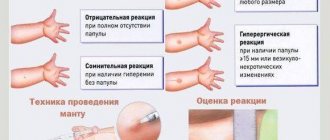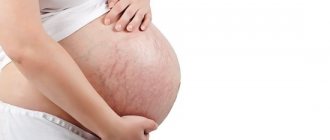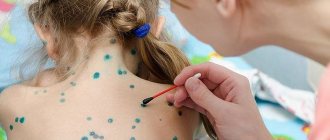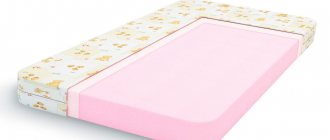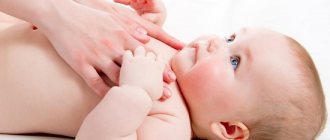With the beginning of the bathing season or if the child is very small and you bathe him in the bathtub, ear problems may begin. Quite often, children get water in their ears. Today we will look at how to deal with this. It is worth saying right away that such situations often happen not only with infants, but also with older children. Sometimes water getting into the ear can cause a lot of problems even for an adult, but it’s not even worth talking about a child. If water gets into the ear of a healthy child, then there is no reason to worry. Of course, water from the ear must be removed as quickly as possible, but this is unlikely to lead to any complications or illnesses.
When bathing a newborn baby, water gets into the ears: is it dangerous, what to do?
Bathing a baby is a mandatory procedure, which is carried out for the first time the very next day after discharge from the maternity hospital. Then the event is repeated daily for the first 6 months (then the frequency of bathing is slightly reduced).
Most often, parents approach this process very responsibly, with great caution and even apprehension. Usually, mom and dad are worried about the question of whether it is possible to wet the ears when bathing a newborn, and what to do if water gets into the baby’s ears.
This article will help you find out the answers to these and other pressing questions.
Bathing a baby is the most important hygiene procedure that cannot be avoided.
Features of the structure of the baby's ears
The structure of the hearing system in an infant is significantly different from that of an adult. In a newborn baby, it is not yet fully formed. The main features come down to several points:
- The auditory canal is shorter than that of an adult. In the latter case, it is branched, long, curved. Babies also have curls, but they are much smaller and shorter;
- The location of the ear canal relative to the shell has a different angle, namely a straight line.
This structure allows fluid that gets into the child’s ear to quickly and easily come out.
Interesting. Since the baby was in an aquatic environment for 9 months, a so-called wax plug formed in his ears.
Its role is to protect the baby’s ears from water getting into them - sulfur does not allow liquid to penetrate too deeply.
After birth, it still persists for some time, but under the influence of water and other factors it dissolves.
Thus, there is no need to worry about whether it is possible to wet the ears of a newborn baby when bathing. Panic in such cases is most often unfounded.
On a note. Experts recommend bathing your child so that his ears are completely submerged in water. As strange as it may sound, such a procedure helps clean and harden the ears.
The structure of children's and adult ears
When water ingress is dangerous
What to do if your child’s ear hurts from snot when he has a runny nose
Is it possible for water to get into a baby’s ears when bathing? The first and most common reaction when water flows into a baby’s ear is panic.
It is very simple to explain this behavior: parents do not have basic knowledge about the physiological structure of the baby’s ear. In addition, ignorance is reinforced by previously heard stories, “scary” stories, and myths.
The latter includes the statement that water may cause a baby to develop otitis media or ARVI. However, this opinion has no scientific confirmation:
- ARVI appears as a result of an infection entering the baby’s body;
- Otitis media is an inflammation of the middle ear. This pathology does not depend on getting the ears wet.
Common misconceptions also include supposed negative consequences such as:
- Swelling of sulfur plug. However, it cannot actually swell from water;
- The occurrence of inflammatory processes that can lead to hearing impairment or even complete loss. The mere entry of water into the ears does not entail the development of infectious diseases and inflammations.
Due to such misconceptions, many resort to protective measures that do not allow water to get deep into the child’s ears (using cotton swabs, headphones, caps).
However, there are situations that really require certain actions aimed at protecting children's ears. The most obvious example is that a child has recently had an acute respiratory viral infection or suffered from otitis media.
Water getting into a child's ears is an inevitable occurrence when bathing.
Correct actions when exposed to water
Cough to the point of vomiting in a child - what to do if a baby is vomiting
The first condition that parents must observe when water gets into their baby’s ears is to stop panicking. The liquid does not get stuck in the ear canal, but flows freely out.
On a note. While bathing, it is impossible not to get your ears wet. Especially if the baby loves to splash in the water.
For small children, water is a native element, a familiar habitat, in which the baby feels very comfortable.
There is no need to rush to your child to quickly wipe his ears. If the baby continues to bathe with pleasure, it is better not to interfere with him in this activity.
As soon as the procedure is completed, the ears should be blotted with a soft, dry towel. If necessary, wipe the auricle with a cotton swab: carefully insert part of the material into the child’s ear with rotational movements. In this case, it is very important not to insert the flagellum deep, otherwise you can damage the eardrum.
Important! If adults are sure that there is a lot of water left in the baby’s ears, the baby’s head should be wrapped in a towel and tilted alternately, first in one direction, then in the other. You need to keep it this way for several minutes - during this time the excess fluid will completely leave the ear canals.
It will not be possible to independently identify which part of the newborn’s ear got water. Liquid quite often enters the middle section through the nose when the baby “inhales” water while bathing. One way or another, if a child feels discomfort and pain (may manifest itself in crying or being capricious after bathing), you should resort to the following actions:
- Make an alcohol compress before bed. To do this, stretch the cotton wool and make a hole in the center (for the ear), soak the material in alcohol, and place it around the ear so that it remains open. Cover the top with polyethylene, and then with a warm wool cloth. The baby is placed on the ear into which water has entered and wait a few minutes;
- A temporary measure until the doctor arrives is to take painkillers. If the baby has severe ear pain (he constantly cries and screams), you can give him the appropriate dose of children's Ibuprofen;
- Apply special drops to the ear (for example, Otipax).
Important! The measures listed are temporary assistance. The baby should be seen by a doctor as soon as possible.
If bathing is carried out in winter, and the room in which the baby is located after the procedure is quite cool, it is recommended to put a cap on the child. Thanks to this, water that gets into the ears and cools over time will not provoke inflammation.
An alcohol compress is an effective way to help a child if there is excess fluid left in his ears.
What not to do
If water gets into a child's ear, parents should refrain from the following actions:
- Removing wax plug from the ear;
- Drying children's ears with a hairdryer;
- Warming up with a heating pad;
- Use of a medical bulb;
- Baby shaking;
- Blowing water;
- Strong rubbing of the ear canals with a towel or cotton wool.
What to do if your child is constantly sick
Such actions often cause more harm to the child than water getting into his ears (which often poses no danger to the baby’s health at all).
Important! Under no circumstances should a cotton swab or tourniquet be inserted deeply into the baby’s ear. If you are afraid of damaging your ears during cleaning, you should purchase baby ear sticks at the pharmacy. Such a device has special restrictions that physically do not allow it to penetrate deep into the ear canal.
Proper ear cleaning prevents deep penetration into the ear canals
How to protect your baby's ears when swimming
To prevent water from getting into your baby's ear canal, you should protect his ears from direct contact with the liquid. One of the most common and effective measures is the use of cotton swabs pre-lubricated with cream or Vaseline.
There are also other ways to protect your baby from water getting into his ears:
- Hammocks and slides to keep the newborn’s body afloat;
- Circles and hats (recommended for children over 3 months).
On a note. It is not necessary to buy or have a custom-made swimming cap. It is quite possible to create such a thing with your own efforts at home. To do this, fabric is selected, then foam is sewn into it and evenly distributed around the cap.
The function of the cap is that it does not allow you to dive headlong into the water, it teaches the baby to stay afloat without being completely submerged. What’s most important is that this device allows you to avoid getting your ears too wet while swimming.
As for the neck circle, it is an inflatable device that is recommended for use when bathing in a large bathtub. The circle performs several useful functions at once:
- Helps the child float and swim;
- Does not allow complete immersion, therefore, protects the ears (as well as the eyes and nose) from water getting into them.
Recommendation. There is a plug of wax in the child’s ears, which formed while still in the mother’s belly. The accumulation of sulfur plays a protective role, including saving the newborn’s hearing aid from water getting into it, as well as various infections. This is why you should not clean your baby's ears before bathing.
So, is it dangerous for water to get into a baby's ears? Water is a natural habitat for a baby. While in the womb, the baby did not require any protective devices to prevent fluid from entering the ear canal. Therefore, you should not get carried away with covering your baby’s ears while bathing.
At the same time, if the baby has recently suffered from infectious diseases (ARVI, otitis), then you will still have to resort to protective measures. In other cases, there is no reason to worry too much about this.
If water gets into your child's ear, there is no need to panic - just get rid of the excess liquid using one of the methods listed above. If the child does not feel better, you should contact a professional who will conduct the necessary tests, make a diagnosis and prescribe treatment (if required).
Source: https://kpoxa.info/sovety-mamam/grudnichku-popala-voda-ushi.html
When can it be dangerous?
Sometimes a baby’s ears really need to be carefully protected from water:
- After suffering from acute respiratory viral infection or other diseases. Doctors usually advise not to bathe babies during illness, and after recovery - to take care of their ears.
- In the first couple of weeks after otitis. It is in such a situation that it would be useful to place cotton wool pads lubricated with Vaseline in the baby’s ears. You can also use a special thick cap. The bathing itself should be short and only hygienic, but not recreational.
- At low temperatures in the room where the bath is located or where the child will subsequently be located.
Thus, protecting your baby’s ears from water only makes sense in some situations. Otherwise, you can bathe babies without fear.
What happens if water gets into a newborn baby’s ear?
Bathing a baby is a mandatory procedure, which is carried out for the first time the very next day after discharge from the maternity hospital. Then the event is repeated daily for the first 6 months (then the frequency of bathing is slightly reduced).
Most often, parents approach this process very responsibly, with great caution and even apprehension. Usually, mom and dad are worried about the question of whether it is possible to wet the ears when bathing a newborn, and what to do if water gets into the baby’s ears.
This article will help you find out the answers to these and other pressing questions.
Bathing a baby is the most important hygiene procedure that cannot be avoided.
First aid
It is important to remember that water itself successfully finds its way back. If the mother is concerned about the presence of foreign fluid in the newborn’s ears, it is necessary to perform a number of manipulations:
- Wipe the ears with a regular clean cotton wool, twisting it into a flagellum. You can use special ear sticks with a limiter. Movements should be circular, smooth and careful so as not to accidentally hurt the baby.
- After the bath, place the newborn first on the right side, then on the left. The procedure takes about 2 minutes for each ear to freely release water.
- Lay the baby down on a warm blanket or heated pillow for a couple of minutes to avoid cooling the ear.
Newborn ears when bathing: should they be covered or can they be wetted?
During the first bath of a newborn baby, every mother has a question - what to do with the ears ? Is it harmful if water gets ? How will the child himself react? We decided to look for answers to all these questions together with you.
Almost every person knows that the ear is an organ with a complex structure. And of course, all adults know the feeling when, when bathing, water gets into the ear and bothers us for a long time.
Of course, every young parent is afraid that his baby will suffer, so many try to completely avoid getting water into their children's ears .
Is it really that scary, let's find out!
Of course, the answer will be: “No, it’s not scary!” A newborn has a special structure of the hearing aid , which is not yet fully formed. The auditory canal is still shorter than that of an adult, and is located at a different angle, which allows any liquid that suddenly enters to flow out freely without remaining inside.
Since the baby spent 9 months actually in water, a special cerumen plug , which at first does not allow the liquid to flow too deeply. Over time, due to exposure to water and many other factors, it disappears. But there is no need to worry about water getting into the ear.
First of all, because of the popular opinion (in the form of advice from grandmothers) that water causes otitis media or ARVI . This is wrong!
- Otitis is an inflammation of the middle ear, which is completely independent of getting the ears wet.
- ARVI also does not arise from this factor, but from infections.
There is no need to focus on this issue. fall in love with water as quickly as possible and learn to behave in it. To do this, you don’t need to be afraid that water will get anywhere.
However, there are certain times when a child should still plug his ears . This should be done in cases where the baby has just suffered from ARVI or otitis media. In this case, the doctor will recommend the most suitable method of protection against water - cotton swabs with baby cream, or some other remedy.
Special products for children
Special products are often used to bathe babies . In the first days of life - all kinds of hammocks and slides to support the body; for older children (from 3 months) you can already use hats and circles .
a swimming cap yourself - you need to sew several pieces of foam into the fabric and place them evenly around a regular cap. This design will allow the child not to dive “completely” , and will teach him to stay on the water.
It will also help keep your ears from getting too wet. When immersing yourself in a large bath, it is also recommended to use a neck circle .
This inflatable device helps the child both learn to swim and float on the water, and will save him from diving and getting water into his eyes and ears .
The most convenient devices for bathing newborns Means for bathing newborns: choosing what you need A hammock for bathing: is it necessary and how to choose A slide for bathing newborns: at what age is it needed, which is better, reviews Circle for bathing newborns: everything you need to know
At the very least, don't panic. As it gets in, it will flow out . While bathing, it is simply impossible not to get the ears wet, especially if the child enjoys the process and loves to frolic and splash.
For a baby, water is a natural habitat; it should be as comfortable as possible. And if parents start rushing to wipe their ears , then the child’s mood will definitely be ruined, which is still better to avoid! If the baby is already calmly splashing around in the bathtub (or bathtub), then you need to allow him to enjoy it as much as possible.
After finishing the washing process, you just need to blot your ears with a towel , and if necessary, wipe the auricle with a cotton swab or cotton wool . This must be done extremely carefully, trying not to insert it deeply, so as not to damage the eardrum.
If you are absolutely sure that there is a lot of water in the ears, wrap the baby’s head in a towel and turn it on each side in turn (for several minutes) so that excess liquid drains out .
IMPORTANT! You should not go deep into your child’s ears, even if it seems to you that there is a lot of earwax there. If you are afraid to clean your baby’s ears with regular cotton swabs, buy baby swabs; the cotton swab is wound on them in such a way that when cleaning the ears, the swab will not go far under any circumstances!
- Shake the baby;
- Dry your ears with a hairdryer;
- Rub the ear canals vigorously with a towel or cotton wool;
- Insert the cotton swab deeply;
- Warm your head and ears with a heating pad.
Many experts insist that it is even necessary to soak the ears in water - for additional hardening.
Opinions from experienced parents
Sergey, Maya (1.5 months)
My wife categorically refused to wet the child’s ears , despite the advice of experienced doctors. It’s unclear where she got this from, but every bath for us is a separate hysteria, and we have not yet been able to establish the process.
As soon as the baby’s head comes into contact with the water, the mother immediately begins to take it out and wipe her ears, and the baby takes on the mother’s mood and also doesn’t like everything.
I found all kinds of advice on the Internet, I hope it will help calm my wife and teach my daughter to swim.
Olya, Ivan (4 years), Marishka (6 months) to dive from a very early age . My son plunged into the water by himself from the age of 2 months, and my daughter from almost three weeks old. There were no otitis media, everyone was happy, and I didn’t even think about water in my ears. Maybe it worked then “you know less, you sleep better”... But in the end, the kids are healthy and swim well under water.
Svetlana, Varya (8 months) From the very birth of my daughter, my mother-in-law tried to tell me that I shouldn’t get my ears wet when washing them.
I fundamentally disagreed with putting a piece of cotton wool with Vaseline in my little one’s ear every day, so I bathed her like that.
Now we live separately, the baby enjoys diving in a large bathtub, and if suddenly the water gets deep and she doesn’t like something, I just wrap her in a towel and put her on her side - the excess water immediately flows out.
Zlata, Marina (6 years old), Anton (3 years old) I never thought about the fact that water would get in there somewhere, because they explained to us in the maternity hospital and clinic that their ears are still structured differently , and the water There's simply nowhere to stay. From a very early age, my children dive calmly and have never had any problems with their ears, and I didn’t even wipe anything with a cotton swab – just a towel on the outside and that’s it. So to the question, is it possible to wet the ears of newborns, I definitely say yes!
Irina, Mitya (5 years old) And in order not to bother, I bought a circle for my neck, and with it it floats in my bathroom. If it suddenly splashes in your ears , don’t worry, there won’t be much there, I’ll blot it with a towel and that’s it.
In this video, Dr. Komarovsky gives the answer to such a burning question that many parents ask from the very first bath of their baby. The answer is simple: “Yes, of course you can!” The doctor explains this nuance in this video:
Natalya Sakhnova, Photo and video: free sources Internet
- The most convenient devices for bathing newborns: finding out what for, determining what we need
- How to use, when to use herbs for bathing a newborn: chamomile, calendula, string, hops, oak bark, sage, herbal collection
- Baby baths for bathing newborns: are they needed, how to choose the right one and how long will you need it
- Everything you want to know about the newborn bathing ring!
Source: https://portalrebenka.com/kupanie/ushi-novorozhdyonnogo-pri-kupanii.html
What should you do if water gets into your baby’s ear while bathing?
> Care >
The process of bathing a baby in the evening is, of course, the most fun and active pastime for a baby, but for inexperienced parents, this positive daily procedure is sometimes accompanied by great experiences when they are lost and do not know what to do.
The baby may swallow soapy water, hit his head on the side of the bathtub while “swimming” in his lap - these, in principle, normal little things for children of the first year sometimes make parents seriously worry. Moms and dads are no less worried about episodes when their baby gets water in his ear while bathing. Are such situations dangerous, and how should parents behave?
- 1 About the structure of a baby’s ears
- 2 What not to do?
- 3 We react correctly
About the structure of a baby's ears
For many adults, water that gets into the ears while swimming causes a lot of inconvenience, ranging from temporary congestion to serious inflammatory processes. When soaking, we immediately feel it and know what to do - we strive to rid the “affected” ear of moisture, so that later we do not suffer from the serious consequences that water that gets into the auditory organs will bring us.
That is why inexperienced parents are very worried when they notice that during water procedures the baby has wet even one ear, and immediately begin to look for a solution on the Internet or torment doctors in the hope of finding out what to do.
In fact, the structure of the ears of adults and infants has significant differences.
- Our auditory canals are very long and have many bends and branches. Sulfur masses are retained in them, swelling when water gets on them, or inflammatory processes begin due to the influence of the liquid.
- In infants, these curls are not so pronounced, and the passages are shorter and located almost at right angles to the auricle. If water gets into the ear of a newborn or older baby while bathing, it will come out freely.
Don’t be afraid to wet your newborn’s ears—the baby still has wax plugs that protected the ear canals during the prenatal period from amniotic fluid getting into them. They gradually “wash out” and move out of the baby’s ears.
Experts even recommend bathing infants so that each ear is simultaneously covered with water - this improves the cleaning of the ear canals from wax and dead epidermal cells. Also, exposure to moisture has a hardening effect on babies’ ears.
What not to do?
Water getting into a baby's ear poses virtually no threat to him, but still such episodes require attention and correct, adequate actions from parents. The following must not be done:
- Dry the baby's ear canals soaked in water with a hairdryer. Hot and drying air can lead to inflammation and death of the epithelium.
- Warm your baby's ears with a heating pad.
- “Blot” the soaked ear canals with cotton swabs, plunging them deep into the ear.
- Use a syringe to remove moisture from the ear canals;
- Shake the baby so that water flows out of his ears.
We react correctly
- At the end of bathing, it is enough to blot the baby’s ears with a cotton pad or a thick cotton ball;
- if you think that you need to blot the newborn’s ears deeper, you can roll up a flagellum of cotton wool and insert it shallowly - no more than 0.5 cm - into the baby’s ear canals;
- after bathing the baby, if he dived a lot or his ears were immersed in water, you can alternately turn him on his sides so that the liquid that gets in flows freely onto a towel or diaper;
- If water gets into the baby's ear canals, so that it does not provoke inflammatory processes, especially in the cold season, after bathing, you need to put a cap or cap on the newborn's head to cover the ears.
If the baby has had otitis media or has recently had a cold, it is better not to take risks and protect his ears so that water does not get into the ear canals.
To close the baby's ear canals during bathing, you can use:
- special silicone plugs;
- ordinary cotton balls, which should be lightly lubricated with Vaseline or baby cream;
- You can put a rubber cap on the newborn’s head, which will prevent moisture from getting into his ears.
If these measures did not help, and after a cold or otitis media the baby behaves capriciously, touches the ear, does not want to eat, sleeps restlessly, and when pressing on the tragus begins to cry, immediately consult an ENT specialist. Even if you already know how to cope with the disease, you still need examination and consultation with a specialist.
What should you do if water gets into your baby’s ear while bathing? Link to main publication
Source: https://NewBabe.ru/uhod/popala-v-uho-voda-novorozhdennomu.html
What should you do if water gets into your child’s ear?
Today, many parents are trying to teach their kids to dive and even swim in the pool literally from the first days of their lives. Therefore, no one is surprised, and certainly not afraid of water getting into the baby’s ears. After all, there are almost always no reasons for fear.
Aware means armed
And yet, some parents experience real panic if water gets into the baby’s ear while bathing. For some reason, they are convinced that after this the child’s wax plug will definitely swell and terrible inflammation will begin, which will certainly reduce hearing or even lead to its loss.
To avoid such a gloomy prospect, moms and dads resort to using a whole arsenal of aids - special headphones, caps and cotton swabs. What is the right thing to do?
If water gets into a newborn's ears, this is a completely normal and natural occurrence. True, in order to come to such a conclusion and be convinced of its correctness, you need to have some knowledge.
The baby's ear has significant differences from the hearing organ of an adult. In the latter, the ear canal is longer, more branched and more curved.
The baby also has all these curls, but they are an order of magnitude smaller and are also located at right angles from the auricle.
This is the reason that liquid poured into the ear immediately comes out without any obstacles and does not linger anywhere.
Pediatricians even recommend carrying out water procedures with the baby in such a way as to ensure that water can get into his ears. At first glance, this sounds like complete absurdity, but, nevertheless, it is necessary for the natural cleansing and hardening of the hearing organs.
The ears of newborns are closed with wax plugs, which served as a barrier against the loss of water while he was in the mother’s stomach. These plugs remain in place for a certain time after birth, so babies, as a rule, are not afraid of water.
Water got into a child’s ear: what should I do?
A classic situation: you were bathing your baby, and suddenly water flowed into his ears. The first priority is to eliminate it. So, after you have finished bathing your baby, you will need:
- Dry the ears using a piece of ordinary cotton wool (it is better to use sterile one). It is advisable to roll a small tourniquet out of it and gently, with a gentle rotation, insert its tip into the child’s ear.
- Pediatricians and coaches involved in swimming with babies advise that after each bathing the baby, turn him first on one side, then on the other. There is another similar option. You can lay the baby on his side on a pre-prepared diaper (it should be dry) for 2-3 minutes, then turn him over to the opposite side. This must be done solely to ensure that water comes out of the ears.
- If water gets into a newborn's ear while bathing, heat can also help remove it. Lay the baby on a blanket, wool blanket or low pillow (all these things should be warm) or use a heating pad (make sure it is warm, but not hot). An alternative option is a compress. To make it, you will need to take a large piece of soft cloth, gauze or cotton wool and soak it with vodka. Then cut a hole in it and place it on the area surrounding the ear so that the auricle is completely open in this hole. Then cover this entire “structure” with thick polyethylene, on top of which place a warm blanket. Lay the baby on his side, with the ear into which the water has flowed down, and hold him in this position for 3-4 minutes.
- In winter, if the newborn is in a cool room after water procedures, you need to put a thin cap on him. The fact is that the water inside the ears gradually cools and can lead to inflammation and the development of infection.
Absolutely forbidden
Has water gotten into your child's ear? The main thing is don’t worry and don’t panic. A much greater danger to a child’s hearing organ is posed by the absolutely inadequate manipulations of mothers and fathers trying to remove it from there at any cost. Let's list what you should never do:
- use cotton swabs after water procedures;
- warm up with a hot heating pad;
- dry your ears with a hairdryer;
- use a medical bulb to pump out water;
- blow out water;
- shake the baby.
All these actions and similar ones cause significant harm to the baby and have an extremely negative impact on his health.
When there is danger
Despite the fact that water flowing into the ears when swimming is normal, there are still times when this should not be allowed:
- with otitis media and during the first 2 weeks after recovery;
- for infectious or viral diseases;
- at low room temperatures (less than 18°C), since water in this case will become a provoking factor for an infectious disease.
If water gets into the ear of a recently ill baby, what should parents do? Of course, get rid of it as soon as possible. Moreover, it will cause discomfort and even pain in the baby. When you notice that your baby is cranky after completing water procedures, cannot sleep and tosses and turns all the time, you should immediately contact your pediatrician.
In addition, it is highly undesirable for children suffering from problems with the immune system to get water into the ears. To avoid this, you will have to completely stop bathing during the recovery period.
How to protect your baby's ears
Sometimes it becomes necessary to protect a baby's ears from water. Today, there are specially designed swimming caps in the form of visors for this purpose. Such a cap is placed on the child’s head, after which all the water during bathing flows through the grooves, and not over the face and ears. As a result, it cannot get into the ears, nose and eyes, which the baby will be incredibly happy about.
These swim caps are usually made from silicone or plastic. Outwardly, they look like a Panama hat, only without the top part.
When purchasing such an accessory for a newborn, be sure to look at the diameter of his hat. The best option is models whose base stretches well.
This item is also supported by the fact that the visor does not rub or put pressure on the small head.
A good and very budget-friendly alternative to caps and visors is ordinary medical cotton wool. Earplugs are made from it. They are good if you need to carefully protect your ear after a recent injury or otitis media.
To prevent water from seeping through a piece of cotton wool, you must first lubricate it and the auricle with vegetable oil or rich cream. This method will help retain and repel moisture.
Basic mistakes
The greatest danger to the hearing organs of a newborn is not water, but the incorrect and sometimes stupid actions of parents caused by panic:
- Using regular ear swabs to not only remove fluid but also clean out wax or even try to remove a plug.
- Drying your ears with a hair dryer (any speed or power of the device will cause harm).
- Warming procedures with a vodka compress or a heating pad, which, according to the older generation, “will not be superfluous.” Sometimes non-interference is much more effective than excessive activity and turmoil.
- Using a blower to remove water from the ears, which can cause serious injury.
- “Blowing out” liquid with the mouth, which, under air pressure, pushes water deep into the ear canal.
- Attempts to “shake out” the liquid by tilting and shaking the newborn in different directions.
